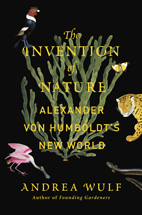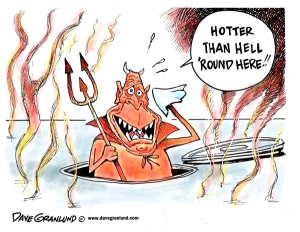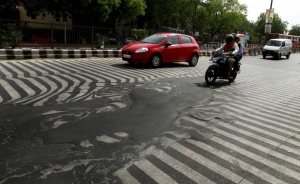In early 2017 I moved roles and did not get time to give attention to this site, but I continued for a few months to bookmark resources relevant to the topic of this site. Today I decided that it is time to clean all the bookmarks, post the relevant ones, and then I will not feel so bad about having done nothing with the bookmarks! So here goes a list of bookmarks I kept between 2016 and early 2017 on anthropology and climate change, and related topics – Part 1 of 2.
Climate change
Morrison TH, et al (2017) Mitigation and adaptation in polycentric systems: Sources of power in the pursuit of collective goals. WIREs Clim Change 2017, 8:e479. doi: 10.1002/wcc.479. Abstract: Polycentric governance involves multiple actors at multiple scales beyond the state. The potential of polycentric governance for promoting both climate mitigation and adaptation is well established. Yet, dominant conceptualizations of polycentric governance pay scant attention to how power dynamics affect the structure and the outcomes of climate action. We review emerging evidence on power within polycentric and distributed governance across the climate, forestry, marine, coastal, urban, and water sectors, and relate them to established positions on power within research on federalism, decentralization, international relations, and networked governance. We develop a typology of design, pragmatic, and framing power that focuses on how and in whose interests power is mobilized to achieve outcomes. We propose that the conceptual model helps to explain power dynamics across different sectors and across both climate change mitigation and adaptation. Significant research challenges arising from the analysis include the measurement and monitoring of the outcomes of power asymmetries over time.
Karen O’Brien and Robin Leichenko (2019) Toward an integrative discourse on climate change – Karen O’Brien, Robin Leichenko, 2019
Billi M, Blanco G, Urquiza A (2019) What is the ‘social’ in climate change research? A case study on scientific representations from Chile. Minerva 57: 293-315. Abstract: Over the last few decades climate change has been gaining importance in international scientific and political debates. However, the social sciences, especially in Latin America, have only lately become interested in the subject and their approach is still vague. Scientific understanding of global environmental change and the process of designing public policies to face them are characterized by their complexity as well as by epistemic and normative uncertainties. This makes it necessary to problematize the way in which research efforts understand ‘the social’ of climate change. How do ‘the climate’ and ‘the social’ interpenetrate as scientific objects? What does the resulting field look like? Is the combination capable of promoting reflexivity and collaboration on the issue, or does it merely become dispersed with diffuse boundaries? Our paper seeks to answer these and other related questions using Chile as a case study and examining peer-reviewed scientific research on the topic. By combining in-depth qualitative content analysis of each paper with a statistical meta-analysis, we were able to: characterize the key content and forms of such literature; identify divisions and patterns within it; and, discuss some factors and trends that may help explain these. We conclude that the literature displays two competing trends: while it is inclined to become fragmented beyond the scope of the ‘mitigation’ black box, it also tends to cluster along the lines of methodological distinctions traditionally contested within the social sciences. This, in turn, highlights the persistence of disciplinary divisions within an allegedly interdisciplinary field.
Swatuk LA (2016) Adapting to climate change: Why the West must learn from Africa and what Africa has to teach itself.
Whitington J (2016) What does climate change demand of anthropology? POLaR 39(1).
Borquez R, Aldune P, Adler C (2017) Resilience to climate change: From theory to practice through co-production of knowledge in Chile. Sustainability Science 12: 163-176. Abstract: In theory, building resilience is touted as one way to deal with climate change impacts; however, in practice, there is a need to examine how contexts influence the capacity of building resilience. A participatory process was carried out through workshops in regions affected by drought in Chile in 2014. The aim was to explore how resilience theory can be better applied and articulated into practice vis-á-vis participatory approaches that enrich the research process through the incorporation of co-produced. The results show that there are more differences in responses by type of actor than between regions, where issues of national interest, such as ‘education-information’ and ‘preparedness’, are highlighted over others. However, historically relevant local topics emerged as differentiators: decentralisation, and political will. This reinforces why special attention must be given to the different understandings in knowledge co-production processes. This study provides evidence and lessons on the importance of incorporating processes of the co-production of knowledge as a means to better articulate and transfer abstract concepts, such as resilience theory, into practice.
Nyadzi E, Ajayi OO, Ajayo OC (2021) Indigenous knowledge and climate change adaptation in Africa: A systematic review. CAB Reviews Perspectives in Agriculture, Veterinary Science, Nutrition and Natural Resources 16: 29.
Ford JD et al (2016) Including indigenous knowledge and experience in IPCC assessment reports. Nature Climate Change 6: 349-353.
Water
Krause F, Strang V (2016) Rethinking relationships through water. Society & Natural Resources 29(6): 633-638. Abstract: With this collection, we hope to contribute to a more explicitly relational study of water in society. Water is not just the object of social relationships, or merely a natural resource on which claims are made, to which meanings are attached, and over which political conflicts erupt. We suggest that if we study how social and hydrological relationships are interconnected and mutually constitutive, a much deeper understanding of the role of water in human social lives can be gained, and significantly better management and policy can be designed. This collection is thus an argument for considering the hydrological and the social together: for thinking relationships through water. Previous research on water has suggested a need to reconsider the relationships between society and natural resources (Strang 2009; Linton 2010). Simultaneously an element, a flow, a means of transport, a life-sustaining substance, and a life-threatening force, the subject, object, and often the very means of social and cultural activity (Hahn, Cless, and Soentgen 2012; Krause and Strang 2013), water inspires novel ways of thinking about key aspects of social relations, including exchange, circulation, power, community, and knowledge. At the same time, watery relationships challenge assumptions about nature and resources, questioning their conceptual and material boundedness and stability and furthering our understandings of the human and nonhuman aspects of their production. Today, water has a prominent place in academic research, due in part to a widening awareness of multiple global water crises, in which water is increasingly scarce, destructive or polluted. As water is perceived as endangered or dangerous, researchers are rediscovering the profound implications of water for human societies and cultures. Just as biophysical life is unthinkable without water, so too is social and cultural life.
Norman ES, Cook C (2016) Negotiating water governance: Why the politics of scale matter. Those who control water, hold power. Complicating matters, water is a flow resource; constantly changing states between liquid, solid, and gas, being incorporated into living and non-living things and crossing boundaries of all kinds. As a result, water governance has much to do with the question of boundaries and scale: who is in and who is out of decision-making structures? Which of the many boundaries that water crosses should be used for decision-making related to its governance? Recently, efforts to understand the relationship between water and political boundaries have come to the fore of water governance debates: how and why does water governance fragment across sectors and governmental departments? How can we govern shared waters more effectively? How do politics and power play out in water governance? This book brings together and connects the work of scholars to engage with such questions. The introduction of scalar debates into water governance discussions is a significant advancement of both governance studies and scalar theory: decision-making with respect to water is often, implicitly, a decision about scale and its related politics. When water managers or scholars explore municipal water service delivery systems, argue that integrated approaches to salmon stewardship are critical to their survival, query the damming of a river to provide power to another region and investigate access to potable water – they are deliberating the politics of scale. Accessible, engaging, and informative, the volume offers an overview and advancement of both scalar and governance studies while examining practical solutions to the challenges of water governance.
Yates JS, Harris LM, Wilson NJ (2017) Multiple ontologies of water: Politics, conflict and implications for governance. Environment and Planning D: Society and Space 33(5). Abstract: We ask what it would mean to take seriously the possibility of multiple water ontologies, and what the implications of this would be for water governance in theory and practice. We contribute to a growing body of literature that is reformulating understanding of human–water relations and refocusing on the fundamental question of what water ‘is’. Interrogating the political–ontological ‘problem space’ of water governance, we explore a series of ontological disjunctures that persist. Rather than seeking to characterize any individual ontology, we focus on the limitations of silencing diverse ontologies, and on the potential of embracing ontological plurality in water governance. Exploring these ideas in relation to examples from the Canadian province of British Columbia, we develop the notion of ontological conjunctures, which is based on networked dialogue among multiple water ontologies and which points to forms of water governance that begin to embrace such a dialogue. We highlight water as siwlkw and the processual concept of En’owkin as examples of this approach, emphasizing the significance of cross-pollinating scholarship across debates on water and multiple ontologies.
Kangalawe RYM (2016) Climate change impacts on water resource management and community livelihoods in the southern highlands of Tanzania. Climate and Development 9(3): 191-201. Abstract: This paper is based on studies conducted in the southern highlands of Tanzania to assess the impacts of climate change and variability on natural and socio-economic environments. Data collection included household and key informant interviews, focus group discussions, historical timelines, resource mapping, and transect walks. Quantitative data were analysed using Statistical Package for Social Science. Qualitative data were triangulated with community members during participatory discussions. Results indicated concerns on progressive decrease of water flows and increasing seasonality of rivers and streams and drying up of some wetlands. Natural springs were reported to have decreased in water discharge or dried up completely. Climate change is locally perceived as the main driver of such changes, particularly associated with declining amounts of rainfall, shortened rainy seasons, delayed onset of rains, increased drought, and increasing temperatures. During the last few decades, unreliable rainfall in upland areas has resulted in increased expansion of agriculture into wetlands, with consequent increase in wetland use, deforestation, loss of biodiversity, and drying and/or shrinking of affected wetland ecosystems. Climate change is also locally perceived to have reduced the overall amount of water coming into the wetlands, causing them to dry much earlier in the dry season, and wetland crop cultivation cannot be extended much into the dry season as was in the past. This has limited agricultural productivity in these areas. These findings point to the need for appropriate water resource management strategies to ensure environmental sustainability and community livelihoods especially within the context of changing climate.
Hastrup K, Hastrup F (eds) (2015) Waterworlds: Anthropology in fluid environments. Berghahn.
Anthropocene
Ellis E, Maslin M, Boivin N, Bauer A (2016) Involve social scientists in defining the Anthropocene. Nature 540: 192-193.
Bronislaw Szerszynski (2016) Gods of the Anthropocene: Human and inhuman agencies in the Earth’s new epoch.
Moore A (2015) Anthropocene Anthropology: A framework for contemporary global change research. Journal of the Royal Anthropological Institute 1-19.
Emmett R, Lekan T (2016) Whose Anthropocene? Revisiting Dipesh Chakrabarty’s ‘Four theses’. Rachel Carson Centre Perspectives 2.
Evidence
Parkhurst JO, Abeysinghe S (2014) What constitutes ‘good’ evidence for public health and social policy making? From hierarchies to appropriateness. Social Epistemology Review and Reply Collective 3(10): 40-52. Abstract: Within public health, and increasingly other areas of social policy, there are widespread calls to increase or improve the use of evidence for policy making. Often these calls rest on an assumption that increased evidence utilisation will be a more efficient or effective means of achieving social goals. Yet a clear elucidation of what can be considered ‘good evidence’ for policy is rarely articulated. Many of the current discussions of best practice in the health policy sector derive from the evidence-based medicine (EBM) movement, embracing the ‘hierarchy of evidence’ that places experimental trials as preeminent in terms of methodological quality. However, a number of problems arise if these hierarchies are used to rank or prioritise policy relevance. Challenges in applying evidence hierarchies to policy questions arise from the fact that the EBM hierarchies rank evidence of intervention effect on a specified and limited number of outcomes. Previous authors have noted that evidence forms at the top of such hierarchies typically serve the needs and realities of clinical medicine, but not necessarily public policy. We build on past insights by applying three disciplinary perspectives from political science, the philosophy of science and the sociology of knowledge to illustrate the limitations of a single evidence hierarchy to guide health policy choices, while simultaneously providing new conceptualisations suited to achieve health sector goals. In doing so, we provide an alternative approach that re-frames ‘good’ evidence for health policy as a question of appropriateness. Rather than adhering to a single hierarchy of evidence to judge what constitutes ‘good’ evidence for policy, it is more useful to examine evidence through the lens of appropriateness. The form of evidence, the determination of relevant categories and variables, and the weight given to any piece of evidence, must suit the policy needs at hand. A more robust and critical examination of relevant and appropriate evidence can ensure that the best possible evidence of various forms is used to achieve health policy goals.
Evidence for nature and people: Data portal
Decoloniality
Rochberg F (2017) Before nature: Cuneiform knowledge and the history of science. In the modern West, we take for granted that what we call the “natural world” confronts us all and always has—but Before Nature explores that almost unimaginable time when there was no such conception of “nature”—no word, reference, or sense for it. Before the concept of nature formed over the long history of European philosophy and science, our ancestors in ancient Assyria and Babylonia developed an inquiry into the world in a way that is kindred to our modern science. With Before Nature, Francesca Rochberg explores that Assyro-Babylonian knowledge tradition and shows how it relates to the entire history of science. From a modern, Western perspective, a world not conceived somehow within the framework of physical nature is difficult—if not impossible—to imagine. Yet, as Rochberg lays out, ancient investigations of regularity and irregularity, norms and anomalies clearly established an axis of knowledge between the knower and an intelligible, ordered world. Rochberg is the first scholar to make a case for how exactly we can understand cuneiform knowledge, observation, prediction, and explanation in relation to science—without recourse to later ideas of nature. Systematically examining the whole of Mesopotamian science with a distinctive historical and methodological approach, Before Nature will open up surprising new pathways for studying the history of science.
Sofoulis Z (2016) From integration to interaction: A knowledge ecology framework.




